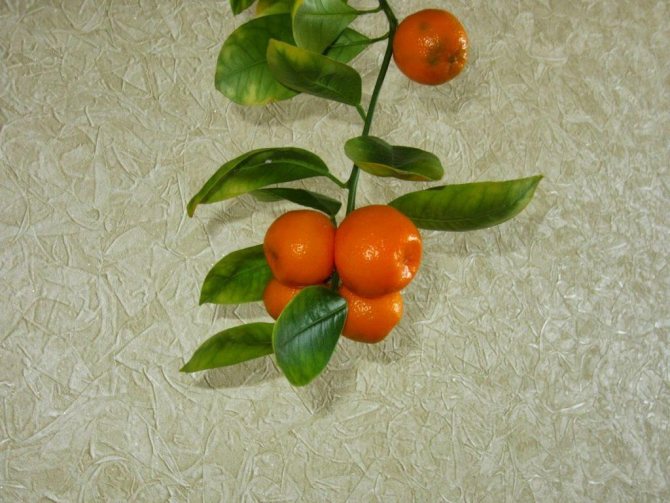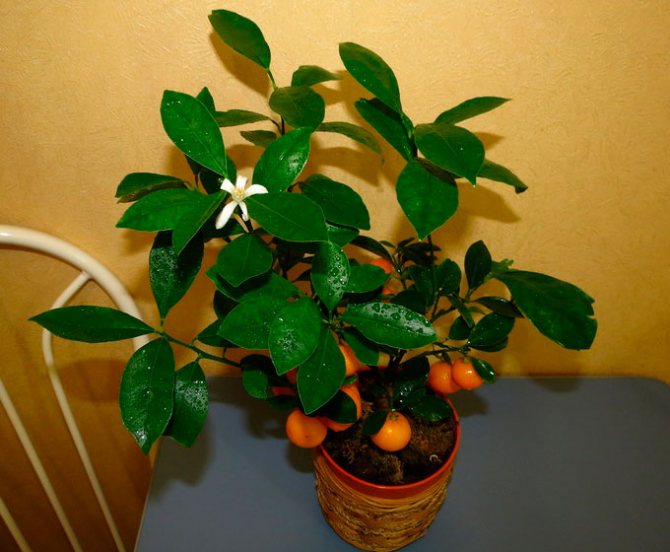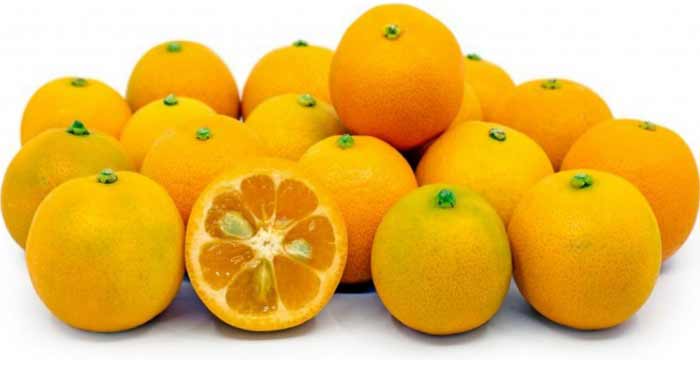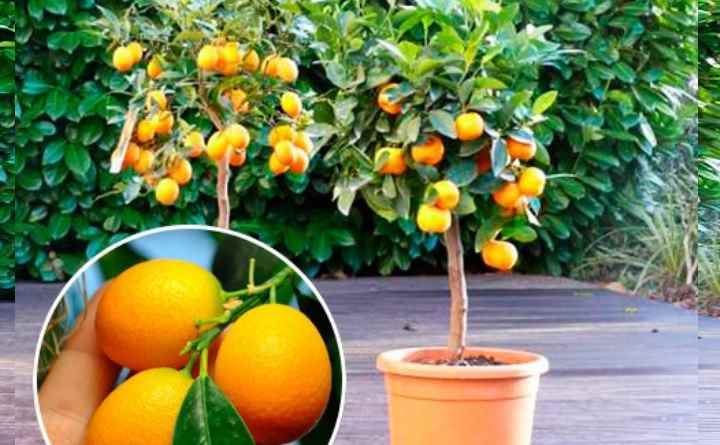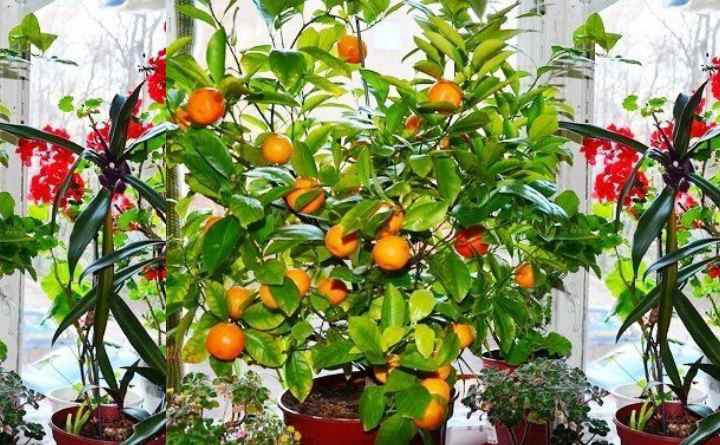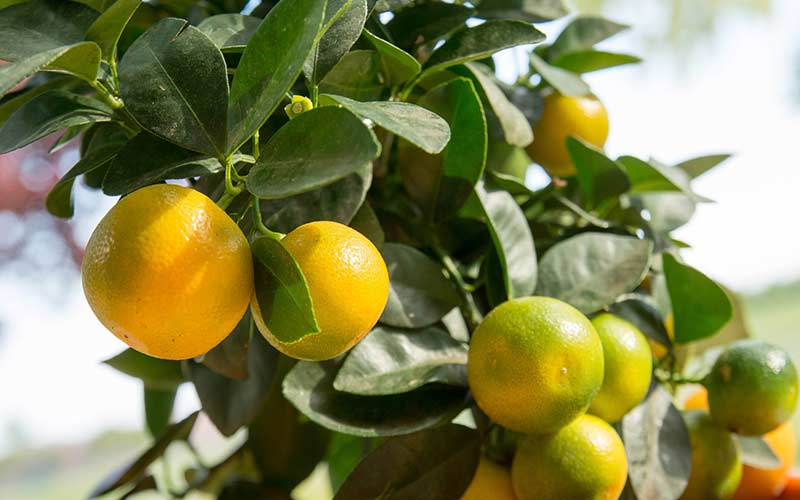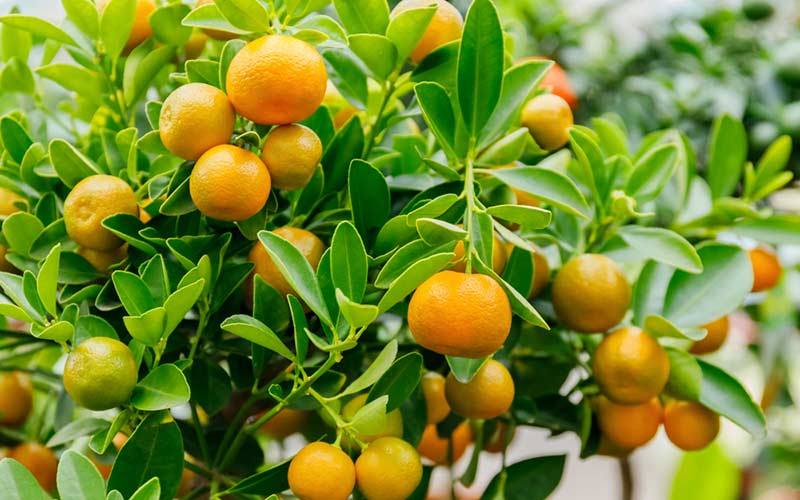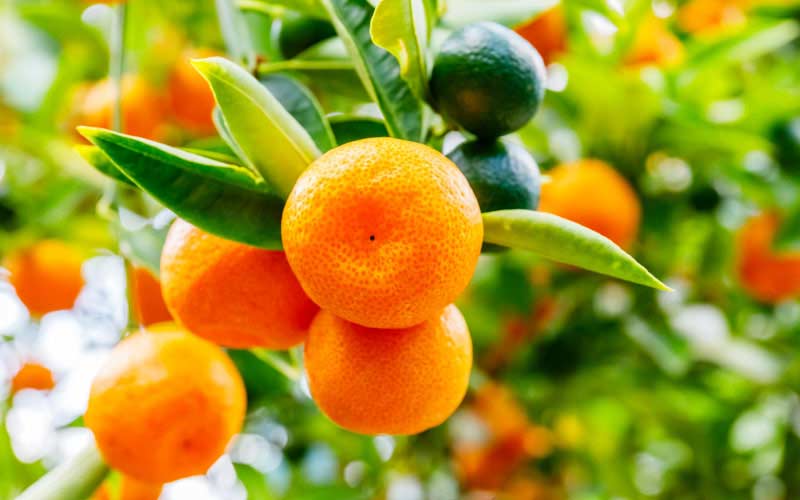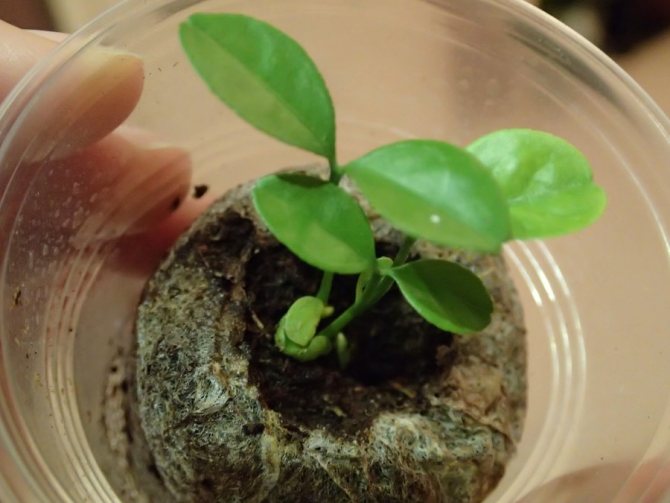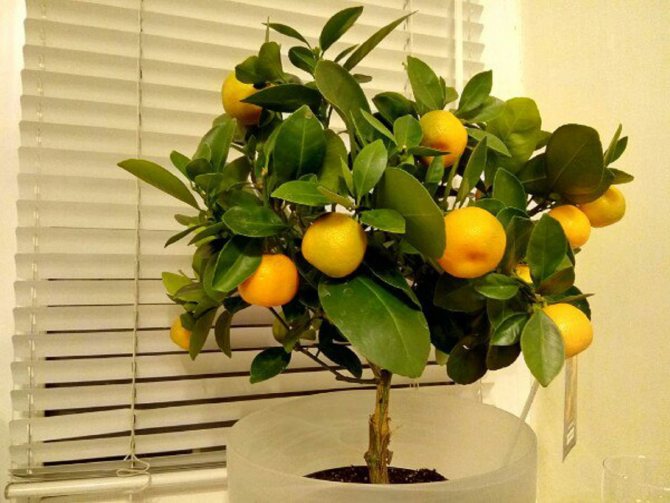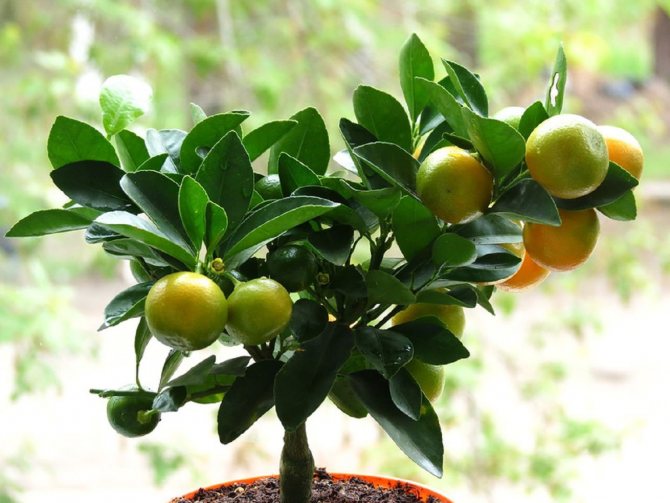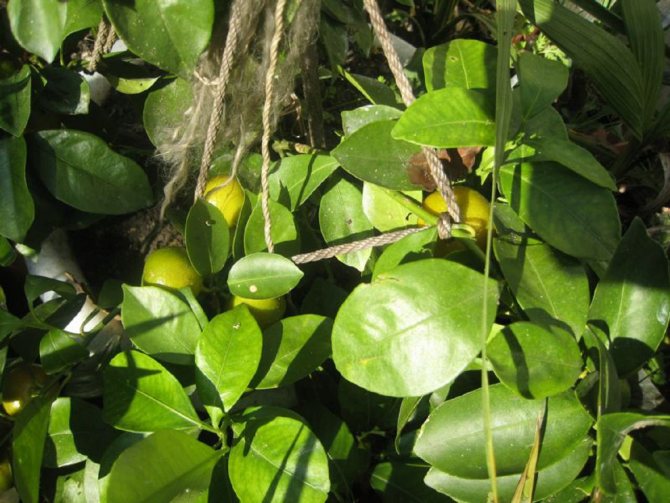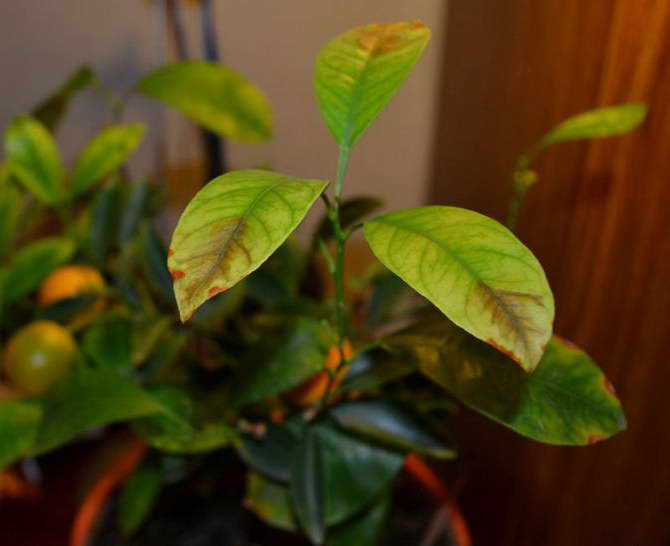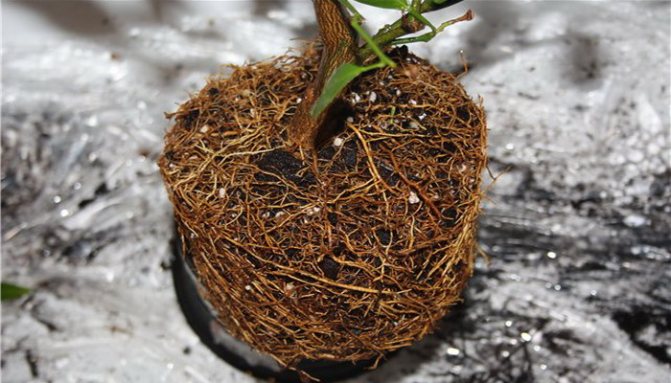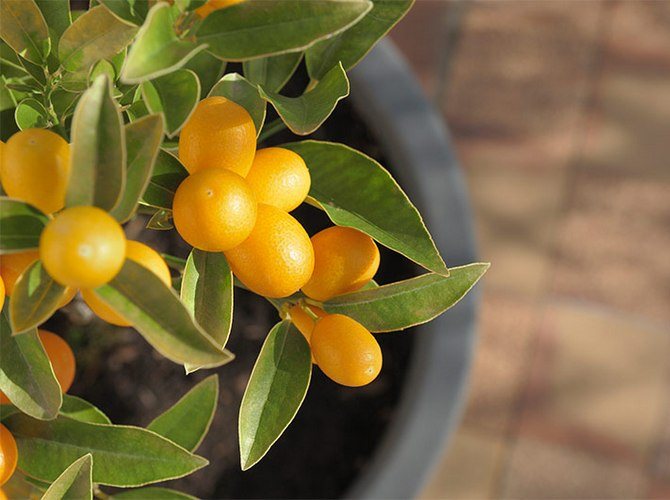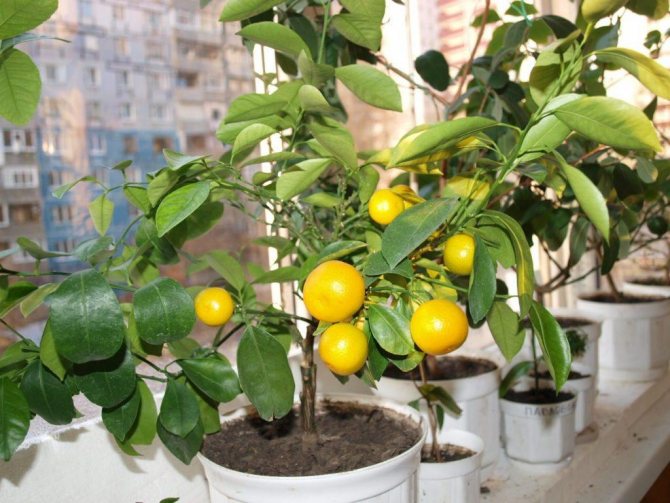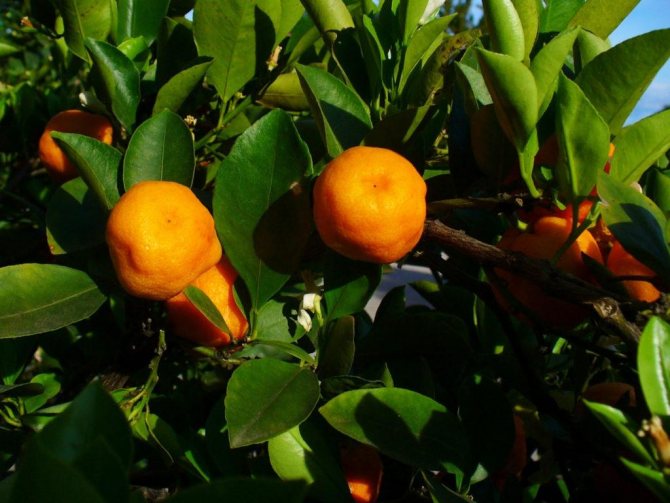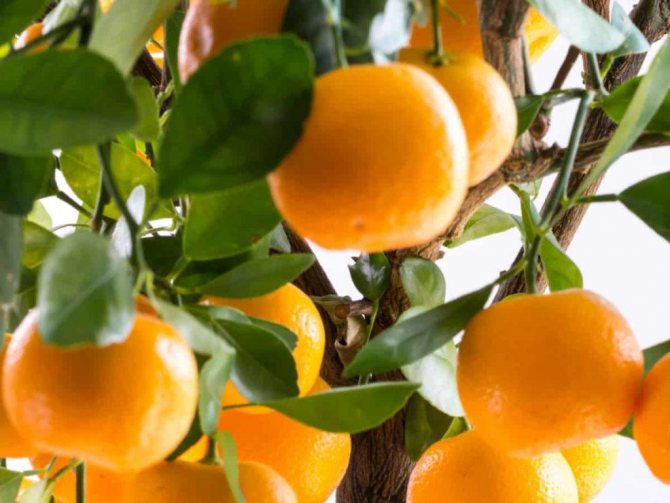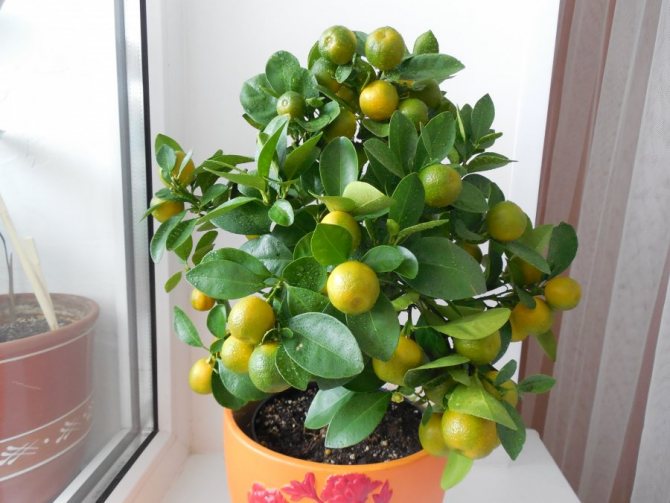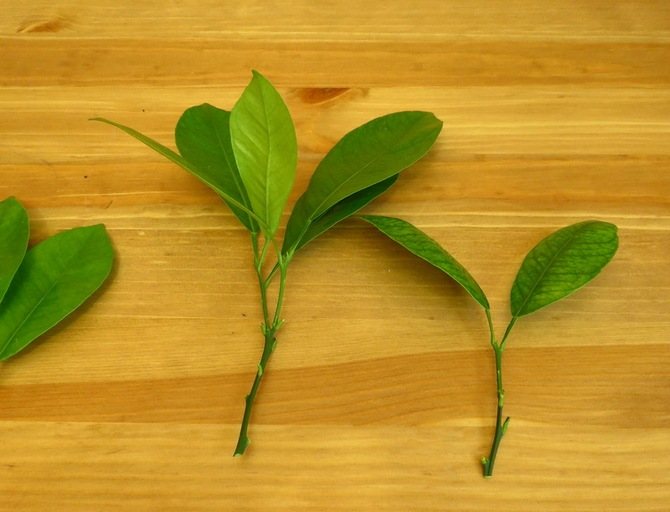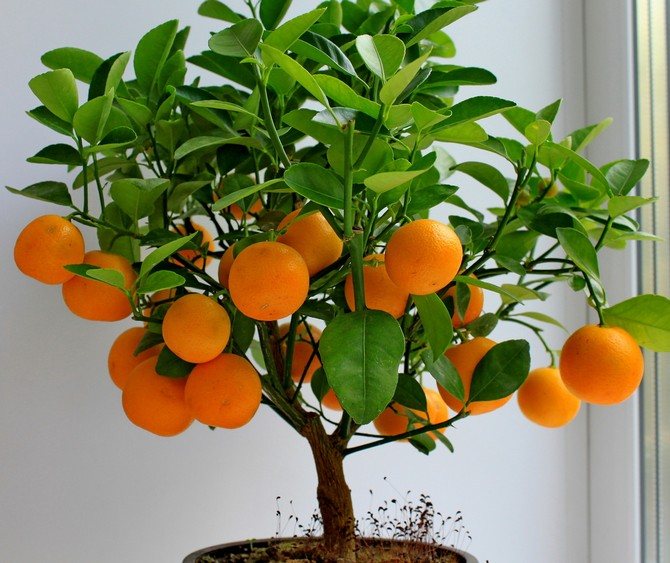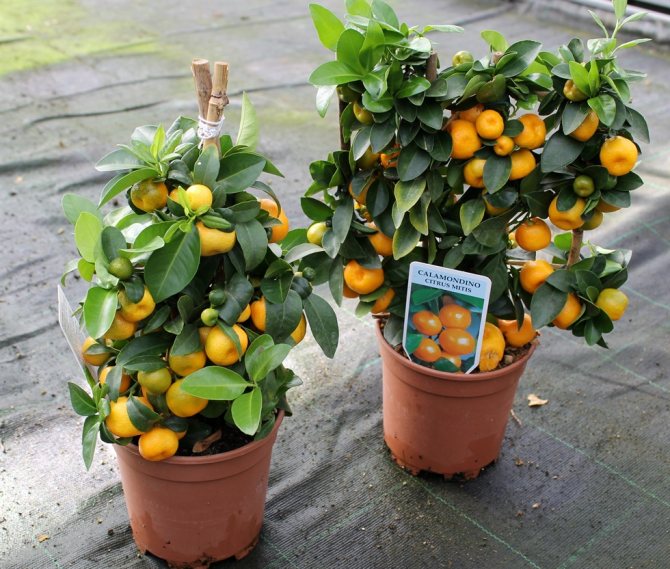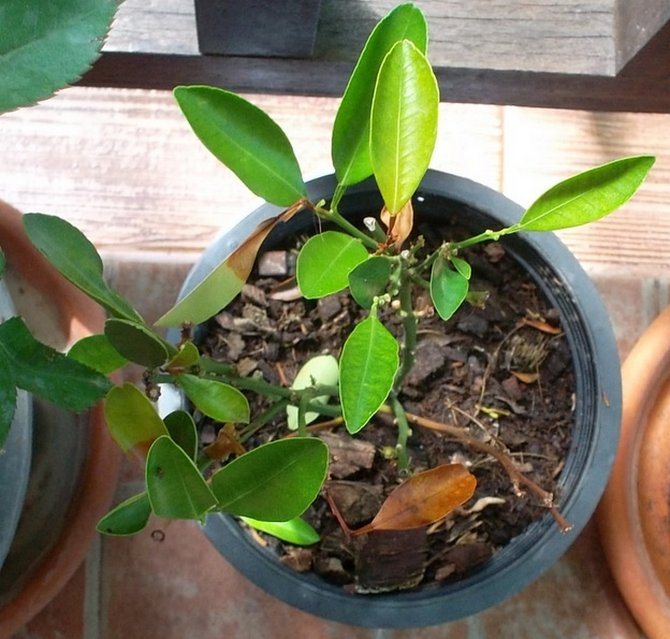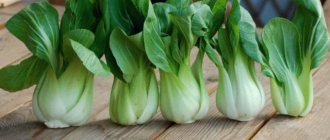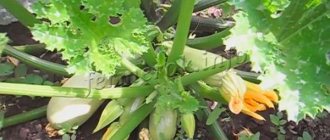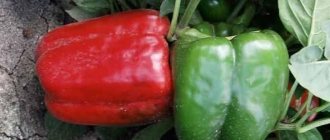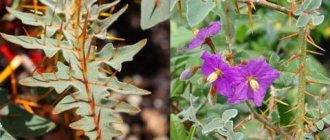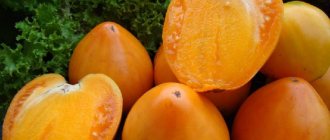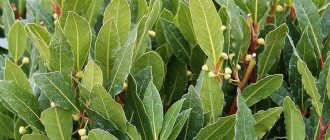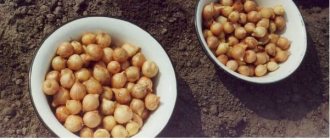Calamondin or citrofortunella is a hybrid bred indoor plant of the Rutaceae family, which also includes lemons, oranges, tangerines. Obtained by crossing mandarin and kumquat. The scientific name is citrofortunella, the household name is homemade tangerine, golden orange.
Bred in the rank of bonsai art for breeding copies of real trees in the apartment.
Description and features of Calamondin
The tree reaches a height of 1 meter. Leaves are dense, dark green, glossy on top. When broken or rubbed in the hands, they exude a characteristic citrus scent. The trunk is light gray, moderately branched. The flowers are white with yellow stamens, with a strongly pronounced aroma of orange (orange blossom).
Calamondin was bred in the tropical climate of Southeast Asia. When kept in the house, citrus needs warmth and high humidity. Unpretentious, grows well and bears fruit even at home. In place of the flowers, ovaries with a pinhead are formed. Over time, the fruits grow and reach a size slightly smaller than that of regular tangerines. Ripening sign is orange color. There are many small bones inside.
Flowering begins at 3-4 years of age. Fruits are formed in good light, warmth and humidity.
Winter care
As we already noted at this time, the features of care may differ slightly from the usual ones. Firstly, it should be noted that, even despite frost resistance, the best temperature for a tree is considered to be about twenty-three degrees above zero, while the air humidity should be high - about seventy percent. In addition to these factors, you also need to take into account the fact that the crown and roots of the plant should be in approximately the same conditions. If you disturb this balance by improper watering or not observing external conditions, you can damage the plant - this will be noticeable by the fact that the leaves will simply begin to fall off. Another sign of such a violation can be considered dropsy, in which case the roots of the plant consume a very large amount of moisture, and growths will appear on the lower part of the foliage. If this happens, then you will not return the previous type of plant.
But back to winter care. At this time, you need to move the plant to a cooler room - preferably, the temperature in it is about fifteen degrees or even lower (but not lower than ten). It is best to start such a movement in November and continue right up to February. If you do everything right and give the tree a rest in winter, then in the spring you will get a lot of fruits and accelerated growth. Otherwise, the plant may die within four years.
Post-purchase Calamondine adaptation
At home, the plant should be placed in a bright place, sprayed daily, the soil should be well moistened, make sure that it does not dry out, otherwise the leaves may begin to fall off.
Ordinary water is not suitable for irrigation, it needs to be defended or filtered. You can use boiled cooled.
Citrofortunella does not tolerate bright rays of the sun. Delicate thin roots do not tolerate overheating, so you need to plant it in a light pot or wrap it with foil, which will give a reflective effect. Sometimes it is enough just to shade with a regular tulle curtain.
You cannot turn the plant sharply by 180 ° towards the light, the position of the pot must be changed, but slowly, moving a few degrees clockwise every day. With this approach, the crown will develop evenly.
The optimum temperature for citrofortunella is from +25 ° C in summer to +18 ° C in winter. A cool room during cold seasons is natural for citrus fruits and promotes better flowering with increased daylight hours in spring.
In the autumn-winter period, care consists in artificial lighting, the intensity and duration of which must be controlled depending on the well-being of the plant. At the same time, the number of waterings is reduced, but the number of sprays is increased.

Top dressing begins during the flowering period. Fertilizing once every 7-10 days from March to September will make caring for calamondin at home even more effective. You can use special formulations or buy ready-made citrus humus. During the dormant period, apply fertilizers no more than once a month.
After two weeks of adaptation, the home tangerine must be transplanted, since suppliers often add hormone-containing drugs to the soil, which, in a city apartment, can harm the plant and even lead to death.
Transplant, pot, soil
For transplant, take a slightly larger container. Determining the required volume is simple. The old pot should fit easily into the new one, there should be about 1-1.5 cm between their edges.
Carefully transfer the plant so as not to damage the thin young roots, together with a lump of earth, into a new container. However, you need to carefully examine them and remove the rotten ones, if any. The root rosette should be recessed at the same level.


Sprinkle new earth from the sides and top. In the future, replanting is extremely rare, since plants using the bonsai technique grow in a small container. One transplant is enough every three years. The rest of the time, the plant cannot be disturbed. Instead, replace the soil periodically as follows: remove the top layer and add fresh soil. Composition: sod land, river sand and humus (2: 1: 1).
At the bottom of the container, it is necessary to arrange good drainage to a height of 3 cm. Top dressing after transplantation is not carried out for 1-2 months. Calamondin will take all the nutrients it needs from the soil.
It is not recommended to transplant citrofortunella while it has flowers or ripe fruits; it is impossible to even transfer the plant to another place during this period.
Pruning calamondin
The tree needs regular crown formation. Modern requirements imply a stem - an even trunk without knots, from the root zone to the first branches, a height of about 25 cm.
You need to start pruning in February, carry out to the branches of the 4th level. In the summer, cut off uneven shoots that have grown from above.
Reproduction of calamondin
You can propagate calamondin with good care at home in three ways:
- cuttings;
- graft;
- growing from seeds.


The last one is the simplest:
- The hybrid fruit contains many seeds. They are selected from the pulp and planted in the ground prepared and treated with a growth stimulant.
- The seed is placed one at a time in small pots with a drainage layer of expanded clay. Tighten with foil or cover with cellophane.
- In the process of seed germination, moisture plays an important role, but periodically the pots are ventilated so that the soil is not covered with a green bloom.
- After the sprouts appear, the film is removed. The branches remaining after pruning calamondin are used as cuttings. For this, strong good shoots with healthy leaves are chosen. Before rooting, they are kept in a solution of Kornevin or Zircon, which stimulate the formation of roots.
- Planting material is buried in the ground before the beginning of the first leaf.Cover the top with a glass jar, plastic bottle or plastic bag. Each day, the seedlings are ventilated for about 30 minutes.
Young shoots of citrofortunella, if cared for at home, will root well and grow in about a month.
Vaccination requires a lot of horticultural experience; it is more often used by professionals in the special conditions of a greenhouse.
Watering rules
Regular drying out of the soil in the pot and dry air in the room cause the plant to weaken and even die. Watering rules:
- The water intended for Calamondin must be soft and clean. For this reason, it is recommended that it be defended or passed through a filter.
- A characteristic sign indicating the need to water the tree is the drying out of the soil by about 2 cm.
- Citrofortunella roots should be kept in a moist substrate. Excessive watering is contraindicated for the plant, since it often leads to the development of putrefactive processes.
- To maintain optimal moisture levels, calamondin leaves should be sprayed daily with a spray bottle.
- From September to October and from March to April, watering the trees should be done with less frequency - the colder, the less often.
- When the sump is filled with water, it must be drained to avoid the appearance of fungus and negate the likelihood of decay of the plant's root system.
Diseases and pests of calamondin
| Name and reasons | External manifestation | Treatment methods |
| Anthracnose or bitter rot is a fungal disease of many fruiting crops. The vectors are insects, water for irrigation, drafts, high soil moisture. Dangerous for its rapid spread. | On all aboveground parts of the plant, brown, then brown spots may appear, which are signs of destruction. As a result, leaves are shed and die. | Removal of damaged parts. Disinfection of the place where the citrus calamondin stands. Spraying with a solution of copper sulfate (1 teaspoon per 1 liter of water) or Bordeaux liquid (1%). And also for prophylaxis 2 times a year, before and after flowering. |
| Sooty fungus (rabble) is an infection that affects young or weakened seedlings. Lives in the soil, is activated under favorable conditions - warmth and humidity. | Small dark gray spots on the leaves and fruits prevent the plant from breathing, clog the pores and interfere with photosynthesis. As a result, the leaves fall off, the tree dies. | Mandatory quarantine of newly acquired plants. The use of strengthening drugs - immunostimulants. Removal of damage by washing with a cotton swab dipped in a solution of laundry soap and wood ash, baking soda. Severely damaged areas are destroyed, thickened ones are thinned out. Replacement of soil. |
| Hommosis (gum disease, brown rot) is a specific disease that occurs in citrus fruits grown at home. It occurs due to damage to the trunk, excessive thickening, lack of drainage and waterlogging, improperly selected soil composition, irrigation with very cold water. | First of all, there is a noticeable discharge that looks like resin - a sticky liquid of a light yellow hue on the trunk and branches. The bark dies off, the leaves brighten, the ovaries fall off, the flowering stops. | Since there are a lot of reasons for the appearance of the disease, it is initially necessary to determine why exactly it arose. A transplant with a complete replacement of the soil and flushing of the plant roots is mandatory. Cutting out damaged areas with a razor or scalpel until they are completely healthy. Treating incisions with a disinfectant such as lime. Spray the aboveground parts with copper sulfate. |
| Insects - aphids, scale insects, whiteflies, spider mites, mealy root bugs. They are transferred with the soil, get in with drafts, start up with excessive watering and overheating of the root system. | Visible to the naked eye in soil, roots, stems, leaves, flowers and fruits. The signal can be the appearance of spots of white, yellow color, twisting, deformation, sticky coating, dusty effect. | Spraying with insecticidal preparations: Fitoverm, Iskra-Bio. From folk methods - washing with a solution of potassium permanganate, alcohol, furacillin. To make it easier to apply and keep the liquid on the leaves longer, add a drop of dish detergent and foam. |
Calamondin transplant
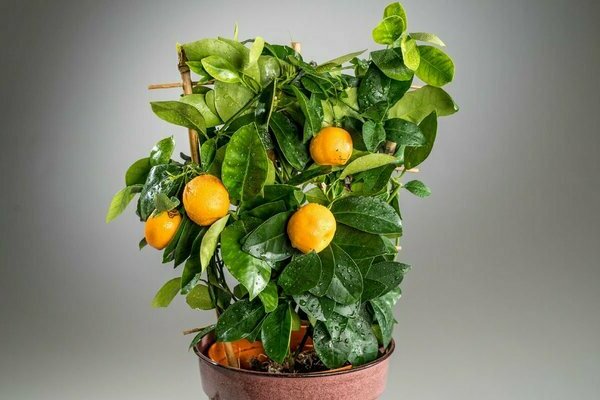

To transplant an adult calamondin, it is necessary to choose a container with a larger volume, since calamondin has a powerful root system. It is also recommended to keep an earthen lump during transplantation. A thick layer of drainage should be laid out, and then during planting it is necessary to ensure that the root collar remains at the same level at which it was located in the old container.
After transplanting calamondin, fertilization should be stopped within 30 days, since there is already a sufficient amount of useful elements in the new soil.
Problems of growing calamondin
Growing citrofortunella will be successful if you pay attention to small but essential details.
| Problem | Cause | Elimination |
| Leaves fall |
|
|
Calamondin reproduction
Experienced growers note that calamondin is not so easy to propagate. The sown seeds germinate for a long time, besides, the first fruits can be seen only a few years after sowing. Cuttings are also very difficult to take root, they do not adapt well, some do not take root. The summer period is suitable for reproduction, when the air temperature will be 23 - 25 degrees. Best of all, if it is July. Light, loose soil is suitable for the cutting, and it is also better to create a greenhouse effect with bottom heating. Special phytohormones will help the cuttings adapt.
Mr. Dachnik recommends: useful properties of calamondine
The fruits of calamondin can be eaten, they are rich in vitamins, they have a sour taste, and the skin is thin. The zest is used in baking, the pulp is added to homemade compotes, and candied fruits are made from peeled whole tangerines.
Even a novice florist can grow calamondins at home. To ensure guaranteed fruiting, flowers are manually pollinated with a cotton swab or soft brush with natural bristles for cosmetics or painting.


Dried fruit peel, rich in essential oils, is used as a natural flavoring agent for household purposes, tinctures and decoctions are used for cosmetic procedures.
Finely chopped leaves in a small amount - no more than 1 is added to add taste of South Asian cuisine to meat, fish, poultry.
Calamondin looks beautiful in the interior, can serve as a background for a photo, is an excellent gift.
Botanical characteristic
Citrofortunella lemon belongs to the rutic family. The evergreen tree is the result of crossing a tangerine tree and fortunella (kumquat). A fast-growing, well-branching plant, compact in size, up to 1 m in height, small dark green foliage and a glossy surface with a pleasant citrus scent. Inflorescences are white, emitting a characteristic aroma.
Citrofortunella has another name - calamondin.
Fruits are small in size, 3.0-4.0 cm in diameter, weighing about 15-25 g, similar in appearance to tangerines, have a thin orange peel. The pulp of the fruit is too sour, with a bitter taste, and resembles kinkan in taste. There are a lot of seeds inside.In citrofortunella fruits, both the pulp and the skin are edible.
It is a self-pollinated plant with a high percentage of fruit set. The possibility of flowering occurs in 2-3 years, in the summer season, the fruiting stage - in the middle of winter. Simultaneous flowering and fruiting is not uncommon.
The life span of a plant is up to 5 years when grown at home and up to 20 years when grown in a natural environment.
Growing geography
The wild home of citrofortunella lemon is the continental and island territories located between China, India and Australia, including the Indo-Chinese peninsula and the Malay archipelago, as well as part of the Asia-Pacific region.
Recently, citrus has become widespread in home floriculture.


